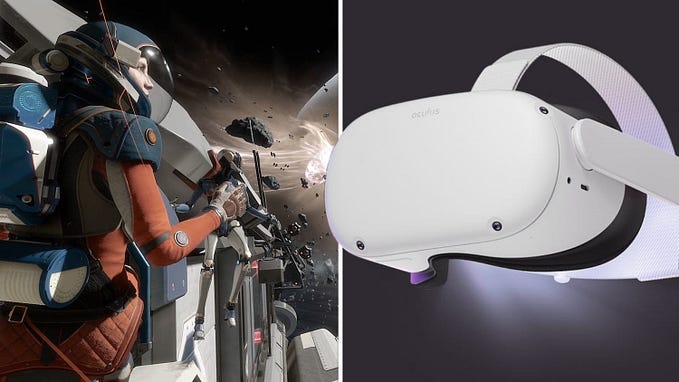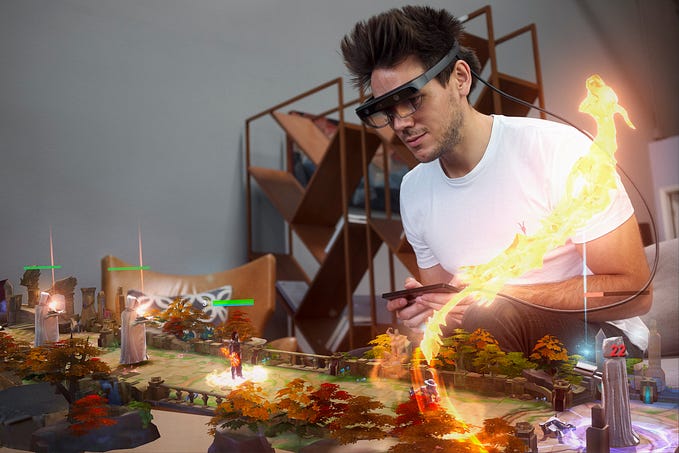The Future of Augmented Reality (updated for 2020–2021)

When we hear the term “Augmented Reality” the first thing that comes to mind is Pokemon Go. However, even though this gaming phenomenon was a watershed moment because it proved that there is a high demand for AR, in terms of the future of AR, it will be in our everyday lives and in the industries where we work or shop. In this article, we will take a look at where AR is headed and the future of augmented reality in our everyday life.
Augmented Reality Future Uses
With the development of augmented reality software in full swing, it will affect the devices we use most often, such as smartphones. In the future, smartphones will be converted into glasses and headsets and everything you currently do on your phone such as updating your Facebook status, calling someone on Skype, using turn-by-turn navigation will all be done thanks to AR glasses via motion and gesture detection.
Speaking of AR glasses, the devices that are currently available on the market today will certainly pale in comparison with future models. All of our senses such as touching, hearing, seeing will all be incorporated into next-generation AR devices, they will have a wider view and they will display information almost anywhere within the user’s peripheral vision. Motion gesture technology will improve as well. For example, in the future, instead of typing in an address into your GPS, you will be able to point to a location and the directions will pop up automatically or you will point at an object or building and receive information about it without even knowing its name.
Trending AR VR Articles:
1. What can Vuzix Smart glasses mean for the current Android Developers?
2. How To Use the ARLOOPA App: A Step-by-Step Guide (2020)
3. Augmented reality for maintenance and repair
4. Top 10 Movies that Got Augmented Reality and Virtual Reality Righ

So far we have discussed the future of augmented reality in our everyday life, now let’s take a look at how it will affect some of the industries we rely on every day.
The Future of Augmented Reality in Fashion and Retail
How many times have you walked by store window displays and seen an item that you instantly fall in love with? Most often than not, this item is an expensive purchase, and deciding on whether to buy it or not consists of several factors. First of all, it looks great on display, but how does it look on a real person? Many brands will include an AR functionality inside their mobile that will allow you to point your camera at any item and not only obtain all necessary information about it, but you will also see AR images of models wearing the clothes. This way, you will have all of the information necessary to make a smart decision without even going inside the store.
The retail industry is not lagging behind either. For example, Sephora has within its mobile app something called the Virtual Artist which allows customers to try on all kinds of lipstick via their front camera. If people like what they see, they can add it to their virtual shopping cart and buy it with their phone. Currently, Virtual Artist has been tried 45 million times.
The Realies & Future of AR in Retail for 2020–2021
Nowadays, because of the pandemic, consumers are hesitant to spend money during an economic downturn. In September 2020, total EU retail sales decreased by, and the total sales volume is now equal to 100.7 % of the volume reached in February before the COVID-19 crisis. This means that retailers need to get creative. This starts with innovative AR advertising that catches peoples’ attention. We created such a 2.0 % compared with August 2020 solution for Finlandia when they launched a new coconut-flavored vodka. All the user has to do is scan the QR on the bottleneck with their smartphone camera, which launches a video with a bartender showing how to make Finlandia Coconut drink. This sort of interactive technology can help companies in virtually any industry attract new customers and stand out from the competition.
As far as e-commerce is concerned, we have seen a 129% year-over-year growth in the United States and Canada. This comes as no surprise since people are hesitant to make a trip to a physical store, and shopping online is just more convenient. However, retailers who have both a brick and mortar location and an online platform need to be able to offer the shopper the best of both experiences. For example, Cosmia offers consumers the opportunity to virtually try on makeup from the comfort of their own homes. Shoppers can try out individual products or ready-made looks, all thanks to AR. This is an innovative way retailers have been able to bridge the gap between in-store and online shopping while also alleviating the fear of buyer’s remorse.
The Future of Augmented Reality in Education
Back in the old days when we were in school, we had a lot of textbooks, looseleaf papers, posters, and many other physical print materials. Thanks to AR, all educational materials will be interactive, digital, and available at any time. This will give a lot more people access to education and offers a higher level of student interaction since lessons can be conducted in a game format.
Also, you can say goodbye to field trips to the museum or art gallery because thanks to AR, the museum and art gallery will come to you and it will be available any time. These are just some of the future uses of augmented reality in education and it is sure to revolutionize the educational process.

AR in Education in 2020–21
Since we have seen a spike in new cases recently, a lot of state officials have decided to close down schools. This is something we see in places like New York City, Detroit, Baltimore, and many others as well. AR can help parents and teachers make learning fun and interesting by allowing the materials in the textbooks to come to life. For example, if a student is reading about Abraham Lincoln or any event in American history, they could point their smartphone camera at the textbook and see a lifelike representation of Abraham Lincoln on that particular event.
This type of technology can also be useful for college students who are also studying remotely, often thousands of miles away from the campus. If they are studying a subject that is difficult to learn on their own, AR can come to the rescue as well. For example, let’s say a medical student is studying a certain aspect of the human heart. Print and video material will not be as helpful because they don’t offer the same level of immersion and interactiveness that they could get with AR. They could use AR to get a lifelike depiction of whatever they are studying which something no textbook can offer.
The Future of Augmented Reality in Healthcare
There are three big roles AR will play in the future of healthcare.
- Consumer Education — AR can help patients understand the benefits and risks of certain medications and procedures by providing visual demonstrations or consumer scanning functionalities. Some companies such as Pfizer are already taking advantage of AR by offering a service called Blippar, which serves as a relief finder tool patients can use with their line of ThermaCare products.
- Assisting Doctors — AR can help doctors by creating serious gaming simulations of how a certain procedure should be done and it can help medical students by offering a very intuitive representation of the human body.
- Medication Sales — The competition among drugmakers is severe and even the slightest advantage can lead to huge sales. If a salesman is trying to gain the attention of doctors towards a new medication, they can use AR to demonstrate the positive effects of the drug.
COVID-19 Influence on AR in Healthcare
The benefits of AR in healthcare we mentioned above are certainly still relevant today, except that they are more oriented towards COVID-19. For example, AR is still used for patient education but now it is geared towards increasing patients’ adherence to treatment and prevention of COVID-19, improving the quality of care of patients with the virus, and eases the overall burden on the healthcare system. Also, since researchers are close to creating a vaccine for COVID-19, AR could be of even greater value by educating patients on how the vaccine works.
Augmented Reality Future Predictions
As you have probably guessed from the information above, AR is now deeply rooted in our everyday life and many industries are rushing to harness all of the benefits. In the future, all of our mundane tasks will become obsolete thanks to AR. For example, if you are tired of your commute to work, there will be all kinds of immersive entertainment. In fact, the office as you know will not exist in the future. Your workspace, meetings, computer etc. will be accessible from anywhere in the world, thus eliminating the need to commute.
So keep an eye out for the latest trends and developments in AR everything is designed to make your life more convenient and enjoyable.
Don’t forget to give us your 👏 !












